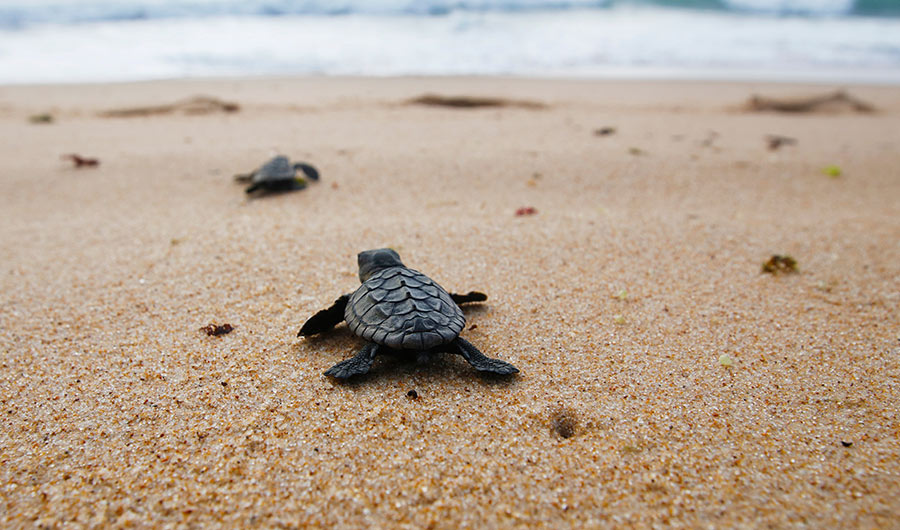Researchers Unravel the Mystery Behind a Turtle's Seemingly Impossible Journey

Salty View via Shutterstock
(Inside Science) -- North Pacific loggerhead sea turtles are extremely sensitive to temperature, which should make it impossible for them to swim through the frigid eastern Pacific Ocean. However, a small number of these turtles defy expectations and somehow make it to the Baja California coast. Until now, researchers had not been able to explain the secret behind this migration mystery, but new findings suggest that rare warm water currents guide them to Baja California.
"I think of it as, really, a major discovery in sea turtle science," said study senior author Larry Crowder, a marine ecologist at two California institutions, the Hopkins Marine Station and the Stanford Woods Institute for the Environment. "People knew for a long time that loggerhead sea turtles were found in Baja California and the Pacific Coast of Mexico, but they didn't know where they came from."
This population of loggerheads nest and hatch on the Japanese coast. From there, baby turtles travel east, usually to the central Pacific, where they stay until they reach a big enough size to make them less vulnerable to predators, then head back to Japan. Most turtles stop traveling further east because, as animals that rely on their environment to maintain their body temperature, they are particularly sensitive to cold water. But some outliers manage to make it all the way across the ocean, maturing in the southern and Baja California coasts. The Stanford team, led by Dana K. Briscoe, and including other contributors, used various methods to "stitch" the turtles' paths to the conditions along their voyage. They published the details in the journal Frontiers in Marine Science.
First, the team noticed that satellite tracking data from 231 turtles identified six that made it all the way to the eastern coast. These six turtles all migrated during years where the water was warmer than usual due to El Nino events. "There's a door that opens when it gets warm, and if the turtles happen to be in the right place at the right time, they can jump across to Baja," said Crowder.
To further explore their "thermal corridor hypothesis," they looked at the atomic makeup of the turtle's humerus bones. Versions of the same element that differ in mass, such as heavier or lighter types of carbon, are present in different amounts in different foods. And for turtles that travel different paths their diets cause differences to show up in their bones, in what's called an isotopic signature. These signatures allow researchers to compare the turtles' diets and determine when they got to the coast.
"For each turtle that had a transition in their stable isotope signature, we could get their arrival year," said Crowder. "More turtles showed up in the warm years, which provides some encouraging support for the hypothesis."
The thermal corridor hypothesis adds a fascinating possibility to consider when studying turtle migrations. Still, it also raises some questions, said Christine Figgener, a marine biologist based in Costa Rica who studies behavioral ecology in sea turtles. One of them is how they get back to their nesting lands in Japan. "It opens our minds to the possibility of thermal corridors that open up and close again," she said. "But I don't know if you're actually able to travel backwards."
While the finding itself is an encouraging revelation, Figgener said it's also an essential insight into the possible effects of climate change. "As temperature shifts and currents actually become warmer or colder it will have an impact on our populations," said Figgener, "but I'm not entirely sure if to the better or to the worst."
In 2014 through 2016, some loggerhead turtles appeared in San Diego, California. "Everybody assumed the turtles that were in Mexico just moved up the coastline," said Crowder. A previous study done by one of this paper's authors analyzed the isotopic signature on skin samples from the San Diego loggerheads. If the turtles had moved up the coastline, they'd expect the isotopic signatures to reflect that of a Baja California loggerhead. But they found the opposite. The turtles had migrated during an El Nino event and the ocean heat wave that followed it. Also, they had not come from a lower coastal area. "Loggerheads showed up in San Diego but they weren't coming from Mexico -- they were coming from the central Pacific." According to Crowder, this is another line of evidence for the thermal corridor hypothesis and a possible explanation for the San Diego loggerheads' arrival.
As the oceans heat up, it may expand the turtles' range to places they have never been before and with that may come more bycatch. "We need to figure out how to keep that environment safe for the juvenile turtles so they can grow up and return to Japan," said Crowder.

